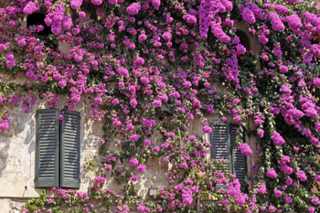The Bardolino wine route
a fine italian red wine made in Veneto, Italy
The scenic settings of the Bardolino wine
Imagine a romantic and relaxing weekend getaway on the Bardolino wine area, wandering around scenic rolling hills dotted with olive trees, cypress trees, vineyards and ancient hamlets. And where the blue of the biggest lake of Italy blends gracefully with the green of the surrounding landscape.
You are in Veneto, but the landscape is blessed with a tuscan atmosphere and mild winters, thanks to the immense expanse of water of the nearby lake of Garda that ensures average annual temperatures of about 12-13C/54-56F.
This is the producing area of this fine italian red wine, whose name comes from one of the picturesque villages on the lake’s shores.
Spending a few days here means dipping into a blaze of colors, flavors and history. Besides the wine, even the variety and quality of the local cuisine is well renowned.
Lake of Garda: a house covered with bouganvillea

Characteristics of the Bardolino wine
The Bardolino is a D.O.C. (guarantee of origin) red wine made in the morainal hills surrounding the lake of Garda.
I may say it is kind of a younger brother of the high-end Amarone wine , made in the nearby Valpolicella hills, being composed of the same grapes variety, such as Corvina, Rondinella, Molinara and Negrara (plus a couple more like Sangiovese and Barbera).
They are two completely distinct wines though. The difference lies both in the making technique and in the diverse microclimates.
In fact, unlike the lighter Bardolino, the Amarone wine - besides aging very gracefully - is partially made through a withering process to dehydrate the grapes and concentrate the sugar, that way increasing the alcohol content.
The soil of the Bardolino producing area is composed mainly of gravel, clay, a high percentage of limestone, and it heats up quickly even in winter.
This way - along with the thermal regulating effect of the nearby lake - the resulting microclimate assures ideal conditions for the vines growing.
The light ruby colored Bardolino is usually lighter and less expensive than Amarone, but it is absolutely note-worthy for its apple/red-berry flavors and mild spicy aftertaste.
Plus, it is a very versatile wine that goes perfectly with the most diverse foods and cuisine. Even with ethnic food.
The more robust Superiore variety, which is obtained from the best grapes belonging to carefully selected vines, must be aged for at least one year.
The three Bardolino wine routes
These are very scenic itineraries, running for about 80Km/50miles between the eastern shores of the lake of Garda and the morainal hills of the hinterland.
You will quickly dip into a breathtaking landscape of natural beauty, and historic and artistic attractions.
Do not forget this is also the producing area of a fine and delicate olive oil.
You will also have the chance to have a break and experience friendly hospitality at one of the over 70 wine farms, restaurants and guest houses.
There are actually three wine routes.
All of the three routes start from the quiet medieval hamlet of Bardolino, the village on the shores of the lake which gave its name to the Bardolino wine.
I recommend you go and take a look at this picturesque village characterized by narrow roads and a nice small harbour, where you can also rent a boat to take a personal or guided tour of the lake.
After visiting Bardolino, continue forward, climb up the hills and you will get to the small town of Costermano.
From Costermano you have three alternatives:
- first option: head for the small villages of Castion and Marciaga. Once there, you can drive down the road toward the village of Garda and then head for Torri del Benaco, first making a detour to take a look at the enchanting Punta Vigilio.
- the second alternative route takes you to Caprino Veronese. From there you can make a detour to the mount Baldo and the village of Spiazzi, famous for its sanctuary named Madonna della Corona. Finally drive down to Rivoli Veronese and Affi.
- the third itinerary runs from Costermano directly to Affi. From there you drive toward the hilly hamlet of Cavaion Veronese.
Continue along the road toward Pastrengo, Castelnuovo del Garda, Pacengo and Colà, as far as the beautiful side-lake hamlet of Lazise.
From Lazise you can head either for Cisano and Bardolino, or take southward toward the side-lake walled small town of Peschiera del Garda.
In the nearby village of Valeggio sul Mincio there is the stunning Parco Giardino Sigurtà, one of the world´s most extraordinary gardens (open from March to November).
From Bardolino wine to Best Italian wine
Return to Veneto Explorer Home Page